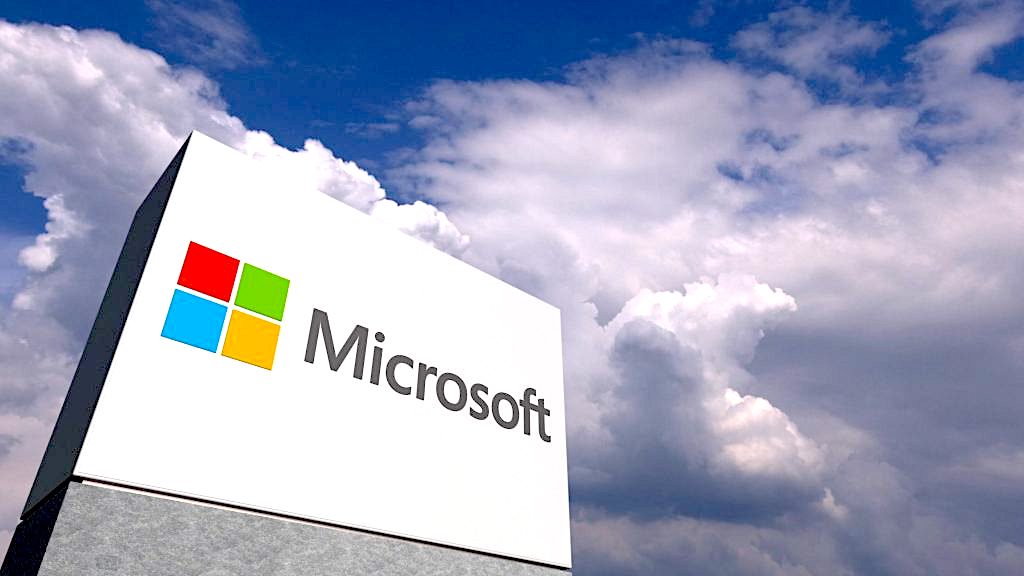 CLOUD
CLOUD
 CLOUD
CLOUD
 CLOUD
CLOUD
Microsoft Corp.’s Azure cloud computing service is the linchpin of the tech giant’s innovation strategy.
As we reported last week, we believe that in the next decade, changes in public policy will restrict the way in which big internet companies are able to appropriate user data. Big tech came under fire again this week with the chief executives of Facebook Inc., Twitter Inc. and Google LLC going toe-to-toe with several U.S. senators.
Microsoft CEO Satya Nadella, however, was not one of those in the firing line. Unlike Google, Microsoft does not heavily rely on ad revenues. Rather, the company’s momentum is steadily building around Azure, which by my estimates is now 19% of Microsoft’s overall revenues, surpassing $7 billion for the first time.
In this Breaking Analysis we will respond to the many requests we’ve had to dig into the business of Microsoft and provide a snapshot of how the company is faring in the Enterprise Technology Research data set.
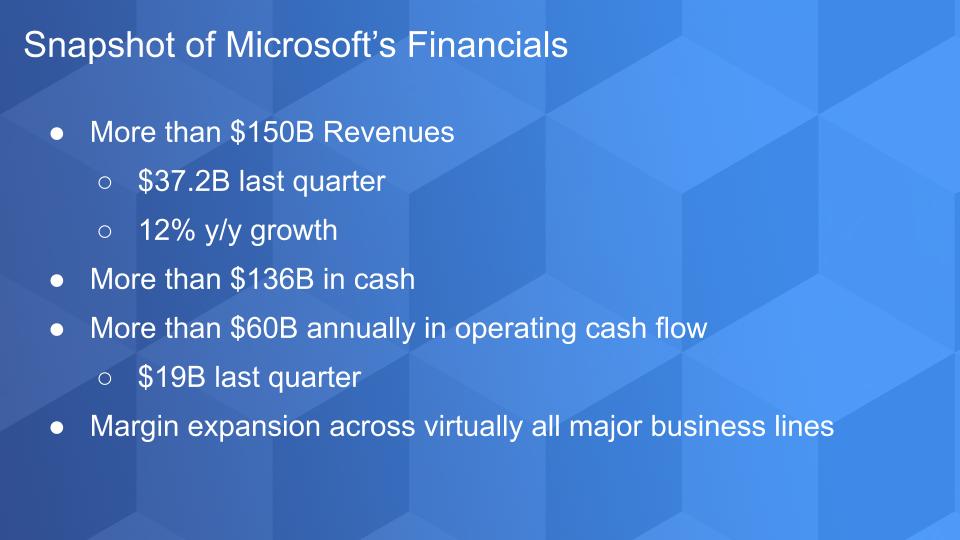
The scope of Microsoft’s business is mind-boggling. The company has roughly $150 billion in annual revenue and grew its top line 12% last quarter. It has more than $136 billion in cash on the balance sheet. It generates more than $60 billion annually in operating cash and last quarter alone threw off more than $19 billion in operating cash flow. Its gross margins are expanding across all of its major business lines.
Microsoft doesn’t suffer from the nagging problem that many older tech companies face. Companies such as IBM Corp., Dell Technologies Inc., Cisco Systems Inc., Oracle Corp. and SAP SE struggle with growth because their growth businesses are not yet large enough to offset the declines in their traditional on-premises segments.
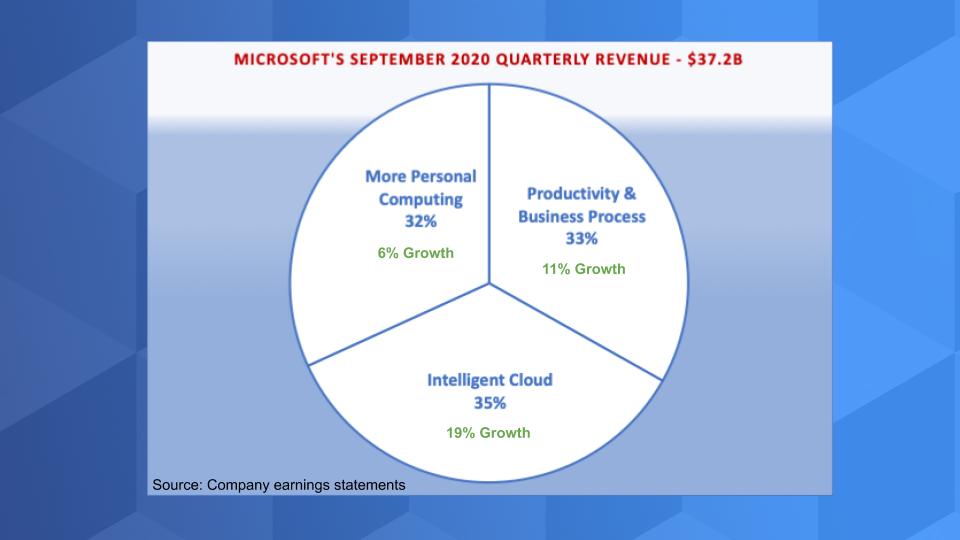
At the highest level Microsoft breaks its business into three broad categories, and they’re all growing quite nicely.
LinkedIn, which is growing at 16%, is in this category, as is Office. This business is shifting from on-prem licenses to the cloud in the form of software as a service with Office 365, which is growing at a 20% clip in commercial markets. Even the consumer side of Office 365 is growing in the double digits. Dynamics, Microsoft’s ERP and CRM business, falls in this slice of the pie and is growing at 18%. The newer Dynamics 365 is growing at 37%. So as you can see, Microsoft is easily able to show growth despite the transitions from its legacy businesses.
Intelligent Cloud is what we call Microsoft’s Cloud “kitchen sink” category – meaning there’s stuff in there that’s includes a bit of “cloud washing.”
But Microsoft is not nearly as egregious as IBM in the liberties that it takes with its cloud categorization. This is a $13 billlion quarterly business for Microsoft and it’s growing at 19%, as we show in the pie chart. Azure is an increasingly large portion of this segment. Azure is the most direct comparison with Amazon Web Services Inc. and our estimates are that this past quarter, Azure accounted for around 50% of the Intelligent Cloud segment, approaching $7 billion per quarter. Azure revenue grew at 47% annually this quarter, the same growth rate as last quarter.
Both AWS and Google Cloud Platform also grew at the same year-over-year rate this quarter as last quarter — AWS at 29% and GCP in the high 50s by our preliminary estimates. AWS revenue was $11.6 billion this past quarter and we have GCP still well under $2 billion per quarter. We’ll be updating our cloud numbers and digging deeper next week, so consider these estimates preliminary for Azure and GCP, which the respective companies don’t break out explicitly for the street.
Microsoft’s Intelligent Cloud business also includes on-prem server software, which is a managed-decline business for Microsoft and is one of the reasons we refer to this category as somewhat cloud washing. Microsoft also includes enterprise services in this category, so as you can see it’s not a clean cloud number for comparison purposes.
Yes, we think this is kind of a dorky name. But nonetheless it’s a nearly $12 billion business that’s growing at 6% annually. The Windows OEM business is in here, as is Windows 10 and some security offerings. Surface is in this category as well and that popular line of laptops/tablets is growing in the mid 30% range. There’s also search revenue, and it’s declining per our earlier statements that it’s not a main piece of Microsoft’s business.
Gaming is also in MPC and is one of the most interesting areas of this sector. Microsoft’s gaming business is growing at 21% and the company just acquired ZeniMax Media Inc. for $7.5 billion.
The gamers at theCUBE are really excited about Microsoft’s Xbox content services, which grew at 30% this past quarter. Game Pass is basically Microsoft’s Netflix or Spotify. You can get in for $5 per month and pay up to as much as $15/month and get access to a huge catalog of games that you can download.
In November of last year Microsoft launched its xCloud beta which allows users to download to a PC or a game box. Now eventually, with 5G, the box goes away. All you’ll need is a screen and a controller – no download. In fact, this is how it works today for Android.
Similar to what happened with Epic Games, Apple is blocking Microsoft and some others such as Google’s Stadia, saying it doesn’t allow streaming game apps such as Microsoft’s xCloud service because these services don’t follow Apple’s guidelines.
What Apple is not telling you is that its adjacent offering, Apple Arcade, is considered subpar by many hardcore gamers, although Apple does have a loyal following. But while Apple allows the streaming of movies and music from any service on iPhone, it doesn’t currently allow streaming games from competitors.
The last thing we want to stress about Microsoft is its leverage point around developers. Developers is a big one. We all remember a sweaty and semimaniacal Steve Ballmer running around the stage like a madman screaming “Developers developers developers,” cajoling the audience to synchronize with his clapping.
Well, despite his obsession with Windows, he sure got that one right. The GitHub acquisition was Microsoft’s way of buying more developer love. It concentrates power with a tech giant, but if it wasn’t Microsoft, it would have been Facebook Inc. or Amazon.com Inc. or Google. Despite some angst in the developer community, GitHub is a linchpin for Microsoft to integrate GitHub more tightly with its tool set.
We said last week that Google needed to look to the cloud and edge and get its head out of its ads. Microsoft recovered from its Windows myopia after Nadella took over in 2014 and by all accounts from the ETR survey data, Microsoft is killing it across the board.
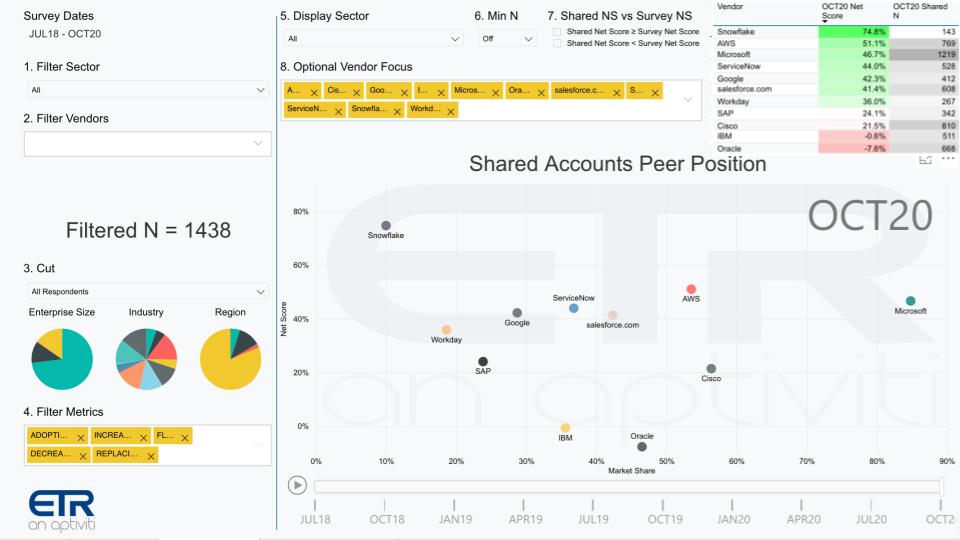
The chart above puts Microsoft in context with some of the most prominent companies that both compete and partner with Microsoft.
This XY graph shows Net Score on the vertical axis, which is a measure of spending momentum, and the horizontal axis shows Market Share, which is a measure of pervasiveness in the survey. In the upper right table you can see the data for each company. This is an ETR survey taken in October with more than 1,400 completes.
Three points stand out:
What makes this so impressive is it represents a pan-Microsoft view across its entire portfolio. And you can see where companies such as IBM and Oracle struggle from a momentum standpoint compared with Microsoft, a much larger company. It’s that problem we referred to earlier regarding the smaller size of their respective growth businesses.
We’d also call out Cisco and SAP, which despite some earnings challenges recently are able to maintain Net Scores that, while not in the green, aren’t in the red either. Green essentially means your overall installed base is expanding. Red indicates a contraction.
The chart below shows the granularity of ETR’s Net Score for Microsoft. The green represents increased spend and the red decreased spending. What’s impressive is that Microsoft’s red zone is negligible at 6% in total. Its customers are all spending more or the same and very few are leaving the platform.
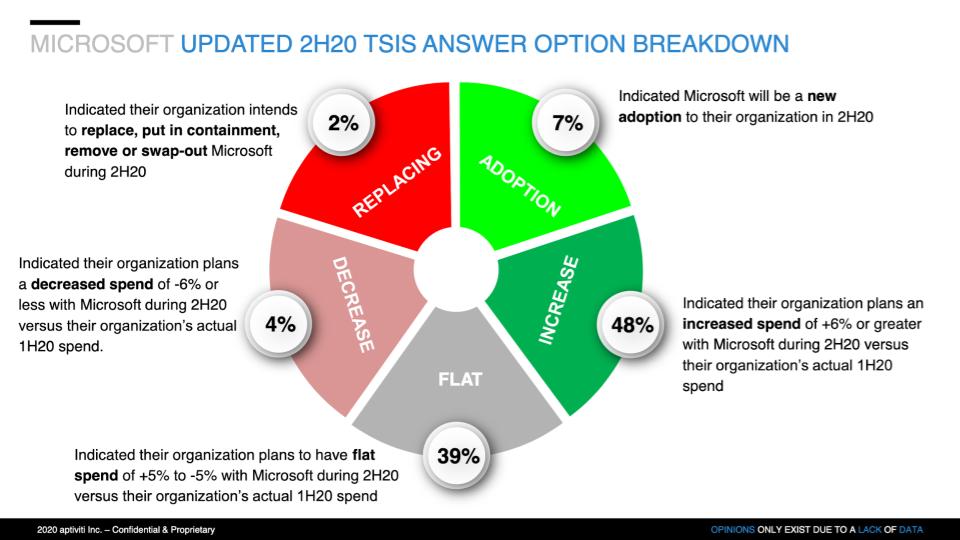
Having spent the past 18 months digging into the ETR data set, we can tell you that for a company of Microsoft’s size and maturity, this is not only uncommon, it’s absolutely unique. Microsoft stands alone in the ETR data as the one very large company that demonstrates aggregate spending momentum equal to focused specialists of much smaller size.
Microsoft has made the transition to a cloud-first business. Most other large on-premises players struggle and focus on three primary strategies:
These are all reasonable strategies, but as we’ve pointed out many times, Amazon launched S3 in 2006 to usher in the cloud era. In 2007, IBM spent far more on R&D than Amazon and Google and similar amounts to Microsoft. But over the next several years, Microsoft directed its research, development and capital resources in a way to compete directly with AWS and become a leader in cloud.
This successful leadership decision created Azure, which powers all of the company’s software and services. Importantly, it allows Microsoft to not only migrate its existing customers to a world class cloud, but also attract troves of new logos to its platform. And all the while it gives Microsoft tremendous operating leverage with steadily improving marginal economics.
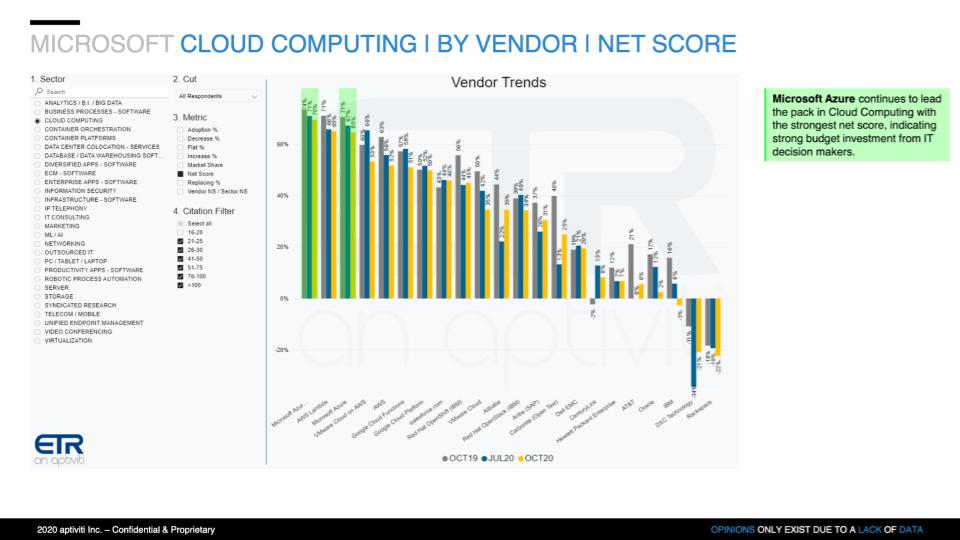
The graphic above shows Microsoft’s position within cloud computing in terms of Net Score. Microsoft Azure functions (No. 1 on this chart) and Azure overall (No. 3) show momentum as strong as any cloud category, including AWS Lambda (No. 2 from the left). Five over from the left, you can see AWS overall and while its levels are elevated, Azure overall (No. 3 from the left) has meaningfully more momentum with a 65% Net Score versus 52% for AWS overall.
Reasonable people can debate the quality of these clouds and argue over feature sets and regions and datacenters and the like — and fairly point out Azure’s struggles with outages. But it’s hard to argue against Microsoft’s “good enough” approach. It’s working and has been for decades.
In the late 1980s, we saw Microsoft first deploy this strategy with Office and it has continued to do so in a number of areas. The latest example is Microsoft Teams. Teams combines features like meetings, phone, chat and collaboration, as well as business process workflows leveraging tools such as SharePoint and PowerPoint. It’s a killer strategy borrowing from Zoom Video Communications Inc., Slack Inc. and other leaders. But it bundles capabilities, integrates them into Microsoft’s vast estate and it all runs on Azure.
You can see the results in this chart below:
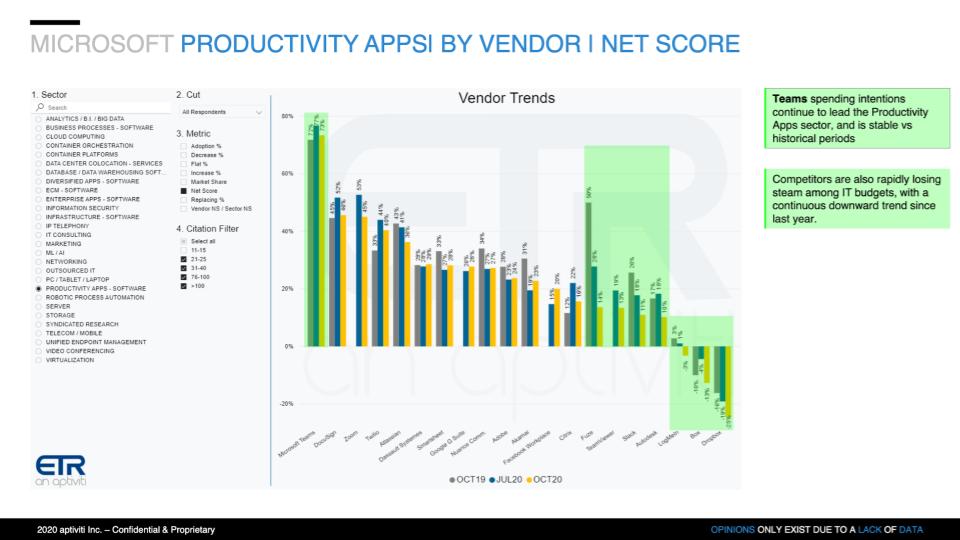
The graphic compares Net Scores from the year ago October survey, the July survey and the most recent October survey with 1400 respondents. Look at the lead Teams has relative to the competition with a 73% Net Score compared with 45% for Zoom and 11% for Slack. Teams is dominating.
The chart below shows Microsoft’s products across the ETR taxonomy — videoconferencing with Teams, productivity apps, RPA, cloud and cloud functions, MI/AI, containers, security, endpoint, analytics, mobile, database. All of these categories show Net Scores over 40% (with the exception of database/data warehouse, which still is in the high 30s). These are extremely impressive signs of spending momentum for a company of Microsoft’s size.
The only signs of softness are seen in the company’s legacy businesses such as Skype or its on-prem license businesses. And though PCs and tablets are weaker than the others, but it’s what you’d expect for such a mature and low-growth business.
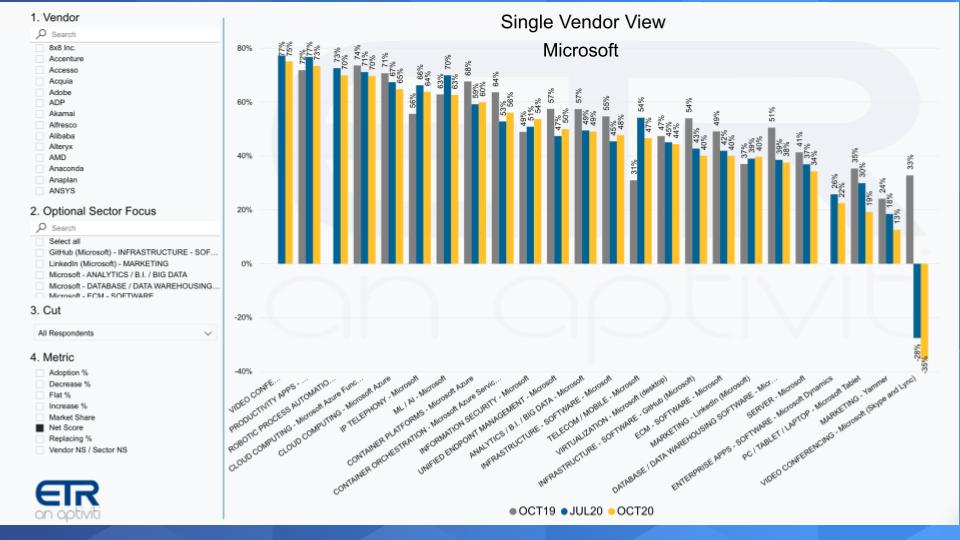
Again, the premise in this post is that by pivoting to the cloud and going all in competing with infrastructure-as-a-service, Microsoft has created a platform for innovation for its business. Its developer chops are credible, it is evolving its installed base to the cloud, and it has a solid hybrid and multicloud story with Microsoft Arc, which eventually it can take to the edge, although we think that Microsoft has some work to do there.
Importantly, the company has a huge partner ecosystem – it even partners with Oracle. As well, it’s using Azure to enter new markets, including vertical clouds such as healthcare. We see this ecosystem play as the next wave of Microsoft’s innovation engine. Going from products to platforms to ecosystems is a powerful lever for the next 10 years. Because there will be so much data living in Azure, its ecosystem partners will be able to collaborate more easily within Azure and create new capabilities for customers, especially as the edge evolves.
It’s the holy grail of cloud and edge and it’s a multitrillion-dollar market opportunity.
There’s really not much on which you can criticize Microsoft. Sure, it has had some high-profile failures, such as the Nokia acquisition, Windows Phone, Zune, Mixer. And Bing – but is Bing a fail? Not really. Maybe the fail is what we discussed last week with antitrust. Microsoft was distracted by the DoJ and maybe that caused it to miss search and give it to Google. In that sense it was a failure, but overall it has a pretty good track record. And really, who wants to be under the social media and advertising microscope today anyway?
Maybe you can say Microsoft is a copycat. Windows copied the graphical user interface of the Mac, but even Steve Jobs got that idea from Xerox PARC. Surface? The cloud? Yes, these were not inventions of Microsoft per se. So what? Ideas are plentiful. Execution is the key.
No matter how you slice it, the data don’t lie. Microsoft’s financial performance, its pivot to the cloud and the success of adjacent businesses make it one of the most remarkable rebirths in the history of the technology industry. We wouldn’t say turnaround because the company was really never in trouble. It just became largely irrelevant for a while.
Today, Microsoft is far from irrelevant.
Remember these episodes are all available as podcasts wherever you listen. Also, check out this ETR Tutorial we created, which explains the spending methodology in more detail. Ways to get in touch: Email david.vellante@siliconangle.com, DM @dvellante on Twitter and comment on our LinkedIn posts.
Here’s the full video analysis:
THANK YOU